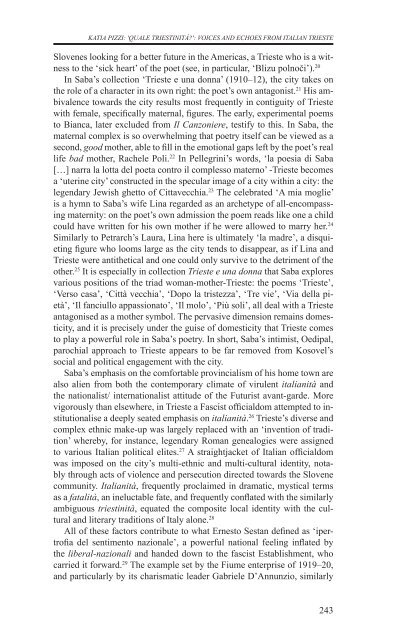razprave (pdf) - Društvo za primerjalno književnost - ZRC SAZU
razprave (pdf) - Društvo za primerjalno književnost - ZRC SAZU
razprave (pdf) - Društvo za primerjalno književnost - ZRC SAZU
- No tags were found...
You also want an ePaper? Increase the reach of your titles
YUMPU automatically turns print PDFs into web optimized ePapers that Google loves.
katia pizzi: 'QUALE TRIESTINITÀ?': VOICES AND ECHOES FROM ITALIAN TRIESTESlovenes looking for a better future in the Americas, a Trieste who is a witnessto the ‘sick heart’ of the poet (see, in particular, ‘Blizu polnoči’). 20In Saba’s collection ‘Trieste e una donna’ (1910–12), the city takes onthe role of a character in its own right: the poet’s own antagonist. 21 His ambivalencetowards the city results most frequently in contiguity of Triestewith female, specifically maternal, figures. The early, experimental poemsto Bianca, later excluded from Il Canzoniere, testify to this. In Saba, thematernal complex is so overwhelming that poetry itself can be viewed as asecond, good mother, able to fill in the emotional gaps left by the poet’s reallife bad mother, Rachele Poli. 22 In Pellegrini’s words, ‘la poesia di Saba[…] narra la lotta del poeta contro il complesso materno’ -Trieste becomesa ‘uterine city’ constructed in the specular image of a city within a city: thelegendary Jewish ghetto of Cittavecchia. 23 The celebrated ‘A mia moglie’is a hymn to Saba’s wife Lina regarded as an archetype of all-encompassingmaternity: on the poet’s own admission the poem reads like one a childcould have written for his own mother if he were allowed to marry her. 24Similarly to Petrarch’s Laura, Lina here is ultimately ‘la madre’, a disquietingfigure who looms large as the city tends to disappear, as if Lina andTrieste were antithetical and one could only survive to the detriment of theother. 25 It is especially in collection Trieste e una donna that Saba exploresvarious positions of the triad woman-mother-Trieste: the poems ‘Trieste’,‘Verso casa’, ‘Città vecchia’, ‘Dopo la tristez<strong>za</strong>’, ‘Tre vie’, ‘Via della pietà’,‘Il fanciullo appassionato’, ‘Il molo’, ‘Più soli’, all deal with a Triesteantagonised as a mother symbol. The pervasive dimension remains domesticity,and it is precisely under the guise of domesticity that Trieste comesto play a powerful role in Saba’s poetry. In short, Saba’s intimist, Oedipal,parochial approach to Trieste appears to be far removed from Kosovel’ssocial and political engagement with the city.Saba’s emphasis on the comfortable provincialism of his home town arealso alien from both the contemporary climate of virulent italianità andthe nationalist/ internationalist attitude of the Futurist avant-garde. Morevigorously than elsewhere, in Trieste a Fascist officialdom attempted to institutionalisea deeply seated emphasis on italianità. 26 Trieste’s diverse andcomplex ethnic make-up was largely replaced with an ‘invention of tradition’whereby, for instance, legendary Roman genealogies were assignedto various Italian political elites. 27 A straightjacket of Italian officialdomwas imposed on the city’s multi-ethnic and multi-cultural identity, notablythrough acts of violence and persecution directed towards the Slovenecommunity. Italianità, frequently proclaimed in dramatic, mystical termsas a fatalità, an ineluctable fate, and frequently conflated with the similarlyambiguous triestinità, equated the composite local identity with the culturaland literary traditions of Italy alone. 28All of these factors contribute to what Ernesto Sestan defined as ‘ipertrofiadel sentimento nazionale’, a powerful national feeling inflated bythe liberal-nazionali and handed down to the fascist Establishment, whocarried it forward. 29 The example set by the Fiume enterprise of 1919–20,and particularly by its charismatic leader Gabriele D’Annunzio, similarly243
















